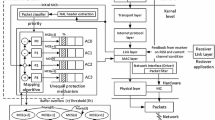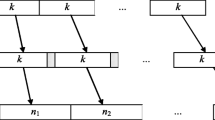Abstract
Received video quality is dependent on the available link rate and the packet loss ratio, which are correlated in a busy network link. Even low packet loss ratios (PLRs) can significantly reduce the video quality. In this paper, a packet level parity Forward Error Correction (FEC) is applied to the video stream in order to reduce the video PLR. A constant gross data rate is assumed, such that adding a FEC leads to a decrease in effective video data rate. The FEC block is truncated at the end of each video VOP, such that there are no inter-VOP dependencies for FEC correction. An algorithm is proposed to optimize the FEC length, based on the Quality of Experience as modelled by the ITU-T R G.1070 standard. It is shown that the optimization algorithm can significantly increase the video quality, without increasing the gross data rate. The algorithm has been evaluated both analytically and through simulations, which confirm the very significant increases in subjective video quality.
Similar content being viewed by others
References
Vaz, R. N., & Nunes, M. S. (2004). Selective frame discard for video streaming over ip networks. In Proc. of the 7th conference on computer networks (CRC2004), Leiria, Portugal, October.
Williams, J. (2008). IPTV QoS/QoE quality model (JDSU, Tech. Rep.).
ITU-T (2007). Rec. G.1070 opinion model for video-telephony applications (ITU-T, Tech. Rep.) April.
A. Li (2007). RTP payload format for generic forward error correction. RFC 5109 (Proposed Standard), Internet Engineering Task Force, Dec. 2007. [Online]. Available: http://www.ietf.org/rfc/rfc5109.txt.
Wu, D., Hou, Y. T., & Zhang, Y.-Q. (2000). Transporting real-time video over the internet: challenges and approaches. Proceedings of the IEEE, 88(12), 1855–1877.
Tan, Y., Wang, H., Wang, X., & Zhang, Q. (2008). A video transmission algorithm over the internet based on fec and Kalman. In IT in medicine and education, 2008. ITME 2008. IEEE international symposium on, Dec. (pp. 263–267).
Feng, J., Xuefen, C., Li, P., Yining, W., & Guan, L. (2009). Adaptive FEC algorithm based on prediction of video quality and bandwidth utilization ratio. In Adaptive FEC algorithm based on prediction of video quality and bandwidth utilization ratio, May (pp. 182–188).
Chan, S.-H., Zheng, X., Zhang, Q., Zhu, W.-W., & Zhang, Y.-Q. (2006). Video loss recovery with FEC and stream replication. IEEE Transactions on Multimedia, 8(2), 370–381.
Rosenberg, J., Qiu, L., & Schulzrinne, H. (2000). Integrating packet fec into adaptive voice playout buffer algorithms on the internet. In Proceedings of the conference on computer communications (IEEE Infocom), Tel Aviv (pp. 1705–1714).
Razavi, R., Fleury, M., & Ghanbari, M. (2009). Adaptive packet-level interleaved fec for wireless priority-encoded video streaming. Advanced MultiMedia, 2009, 1–14. doi:10.1155/2009/982867.
Razavi, R., Fleury, M., Ghanbari, M., & Sadeghzadeh, M. (2007). Delay-aware interleaving and forward-error correction for video over wireless: a bluetooth case study. In WMuNeP ’07: Proceedings of the 3rd ACM workshop on wireless multimedia networking and performance modeling, New York, NY, USA (pp. 46–53). New York: ACM Press.
Tsai, M.-F., Huang, T.-C., Shieh, C.-K., & Chu, K.-C. (2011, in press). Dynamical combination of byte level and sub-packet level fec in harq mechanism to reduce error recovery overhead on video streaming over wireless networks, Computer Networks. Corrected Proof, 2010. [Online]. Available: http://www.sciencedirect.com/science/article/B6VRG-509W7G0-1/2/027fab284e9229da0e952dc942ee0938.
Xiao, W., Agarwal, S., Starobinski, D., & Trachtenberg, A. (2010). Reliable wireless broadcasting with near-zero feedback. In INFOCOM’10: proceedings of the 29th conference on information communications, Piscataway, NJ, USA (pp. 2543–2551). New York: IEEE Press.
Perkins, C., & Hodson, O. (1998). Options for repair of streaming media, RFC 2354 (Informational), Internet Engineering Task Force, Jun. [Online]. Available: http://www.ietf.org/rfc/rfc2354.txt.
Ramsey, J. (1970). Realization of optimum interleavers. IEEE Transactions on Information Theory, 16, 338–345.
Girod, B. (1993). What’s wrong with mean-squared error? (pp. 207–220). Cambridge: MIT Press.
Winkler, S. (2005). Digital video quality—vision models and metrics. New York: Wiley.
Huitema, C. (1996). The case for packet level fec. In W. Dabbous & C. Diot (Eds.), IFIP conference proceedings: Vol. 73. Protocols for high-speed networks (pp. 109–120). New York: Chapman & Hall.
Bolot, J.-C., & Vega-Garcia, A. (1997). The case for FEC based error control for packet audio in the Internet. ACM Multimedia Systems.
Handley, M. (1997). An examination of mbone performance (USC/ISI Research Report, Tech. Rep. ISI/RR-97-450), April.
Yajnik, M., Kurose, J., & Towsley, D. (1996). Packet loss correlation in the Mbone multicast network. In Proc. IEEE global internet conference, Nov.
Van der Auwera, G., David, P. T., Reisslein, M., & Karam, L. J. (2008). Traffic and quality characterization of the h.264/avc scalable video coding extension. Advanced MultiMedia, (2), 1–27. doi:10.1155/2008/164027.
Seeling, P., Reisslein, M., & Kulapala, B. (2004). Network performance evaluation using frame size and quality traces of single-layer and two-layer video: a tutorial. IEEE Communications Surveys and Tutorials, 6(1–4), 58–78.
FFmpeg Project (2010). Ffmpeg encoder. http://www.ffmpeg.org, January.
Gilbert, E. N. (1960). Capacity of a burst-noise channel. The Bell System Technical Journal, 39, 1253–1265.
Fall, K., & Varadhan, K. (2002). The ns-manual. VINT Project. Berkely: University of California.
Ke, C.-H., Shieh, C.-K., Hwang, W.-S., & Ziviani, A. (2008). An evaluation framework for more realistic simulations of mpeg video transmission. Journal of Information Science and Engineering, 24(2), 425–440.
Author information
Authors and Affiliations
Corresponding author
Rights and permissions
About this article
Cite this article
Kuipers, B.W.M., Vaz, R.N. & Nunes, M.S. Video quality protection for real time video streams over wireless networks. Telecommun Syst 52, 2259–2270 (2013). https://doi.org/10.1007/s11235-011-9531-3
Published:
Issue Date:
DOI: https://doi.org/10.1007/s11235-011-9531-3




